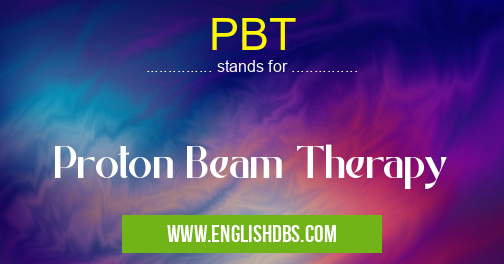What does PBT mean in THERAPY
Proton Beam Therapy (PBT) is an advanced form of radiation therapy used to treat certain types of cancer. PBT delivers protons, positively charged particles, to the tumor site while minimizing damage to healthy tissues surrounding it.

PBT meaning in Therapy in Medical
PBT mostly used in an acronym Therapy in Category Medical that means Proton Beam Therapy
Shorthand: PBT,
Full Form: Proton Beam Therapy
For more information of "Proton Beam Therapy", see the section below.
What is PBT?
PBT employs a particle accelerator to generate protons and a beam delivery system to direct them at the target area with high precision. Unlike traditional X-ray or gamma-ray radiation, protons release most of their energy at the end of their path, known as the Bragg peak. This enables targeted delivery of radiation to the tumor while sparing healthy tissues.
Benefits of PBT
- High precision: PBT allows for conformal treatment to complex tumor shapes, reducing damage to nearby tissues.
- Reduced side effects: The limited energy release outside the Bragg peak minimizes radiation-induced side effects, such as nausea, hair loss, and skin reactions.
- Suitable for sensitive areas: PBT is ideal for treating tumors located near critical structures like the brain, spinal cord, and heart.
- Improved outcomes: PBT can provide better tumor control, survival rates, and quality of life compared to traditional radiation therapy in certain cases.
Applications of PBT
PBT is used to treat a range of cancers, including:
- Head and neck cancers: Nasopharyngeal, oral, and salivary gland tumors
- Eye cancers: Uveal melanoma
- Brain tumors: Gliomas, medulloblastomas, and pituitary tumors
- Prostate cancer: Localized and locally advanced cases
- Lung cancer: Early-stage and inoperable tumors
- Liver cancer: Hepatocellular carcinoma
Essential Questions and Answers on Proton Beam Therapy in "MEDICAL»THERAPY"
What is Proton Beam Therapy (PBT)?
PBT is a type of radiation therapy that uses protons to target cancer cells. Protons are positively charged particles that are much heavier than electrons, the particles used in conventional radiation therapy. This allows protons to deliver their energy more precisely to the tumor, reducing damage to surrounding healthy tissue.
How does PBT work?
PBT works by releasing a precise amount of energy into the tumor. This energy damages the tumor's DNA, preventing it from dividing and multiplying. The protons are delivered in a way that minimizes exposure to healthy tissues, sparing them from radiation damage.
What types of cancer can PBT treat?
PBT can be used to treat a wide range of cancers, including:
- Head and neck cancers
- Eye cancers
- Brain tumors
- Lung cancers
- Prostate cancer
- Breast cancer
What are the benefits of PBT?
The benefits of PBT include:
- Reduced radiation exposure to healthy tissue
- Improved tumor targeting
- Decreased side effects
- Less damage to critical structures, such as the brain and spinal cord
What are the risks of PBT?
The risks of PBT are generally low and may include:
- Skin irritation
- Fatigue
- Nausea
- Diarrhea
- Hair loss
Is PBT right for me?
The decision of whether or not PBT is right for you depends on several factors, including the type and stage of your cancer, your overall health, and your preferences. Your doctor will discuss these factors with you and help you make the best decision for your individual situation.
Final Words: Proton Beam Therapy (PBT) is a state-of-the-art radiation treatment that offers several advantages over traditional methods. Its high precision, reduced side effects, and suitability for sensitive areas make it a valuable tool for treating various cancers. PBT has the potential to improve patient outcomes and enhance quality of life.
PBT also stands for: |
|
| All stands for PBT |
